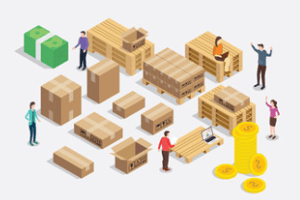A Business Acumen Perspective
The “system of business” is an incredible thing. The global marketplace has become an integrated and diverse ecosystem of innovative companies working together to create and deploy products and services for consumption by business to business and consumers around the world.
diverse ecosystem of innovative companies working together to create and deploy products and services for consumption by business to business and consumers around the world.
In the United States, 47% of the GDP is driven from small to medium sized companies who live in a “food chain” of supplying important products and services to larger companies who then provide products and services to larger companies who provide products and services to even larger companies and so on.
Take the automotive industry for a moment. From super sophisticated electronics that manage the safety defense system to tires, from windshields to sound systems, there are literally thousands of different vendors who supply the pieces that go into the pieces that go into the parts that go into the car.
Even before the Coronavirus pandemic, the automobile industry was experiencing some hard times as consumer lifestyle changes where translating into fewer cars purchased and a downturn in the entire in industry. Now, with dealerships closed and nobody buying cars, the industry is facing unprecedented chaos as the 2-3 month lag of purchasing cascades through the system of business. Inventories will have carrying costs, dealerships will lay off workers, and in a few months, manufacturers will close manufacturing lines and cut jobs. While there will certainly be “pent-up demand” to purchase vehicles again once the cycle is broken, it may be very hard to come back and if certain suppliers are gone, it could disrupt the entire market.
And as we all know, it’s not just the automotive industry that is going to face this potentially devastating problem. It is virtually every industry and every market with the exception of a small group of categories such as toilet paper.
In the days and months ahead, every part and every vendor in the given supply chains will be severely hurting. Hopefully he Federal stimulus bill will help and everyone will survive, but there are things that all of us can do today to insure that at the end of the crisis, markets will survive and the small businesses that drive them will thrive again.
No matter where your company is in the supply chain, remember that you can help a vendor struggling to stay afloat. It could be your outsourced IT professionals, it could be your coffee supplier, or it could be your training vendor. If you find yourself in a business that is higher in the food chain and isn’t having issues with cash flow, then take a few moments to think how you can help a great vendor partner through the next few months.
Here are three ideas that can really help:
Offer to pre-pay in exchange for discounts
A great win-win for a vendor would be a pre- or advance pay for products or services in exchange for discounts. For example, I was speaking with a client who is in the commercial cleaning service business and he shared that some of their large customers were agreeing to pre-pay 3 months of service in advance in exchange for a 15% discount.
Take on inventory for discounts and other concessions
I was speaking with another business owner who supplies a key raw ingredient that is used to manufacture cleaning fluids. They approached their key customers to see of the customers would purchase extra inventory so the company could generate short-term cash flow and they agreed to an advance of 5 months inventory at a discount of 5% for now and 7.5% once the crisis is over.
Offer to lengthen your contract and front load some cash flow
I read another story about an IT company who approached their customers about ripping up their existing services contract agreements in exchange for a lump sum payment upfront and then discounted fees on the backend of the contract which was extended by a year.
In summary, these are just a few of the ways larger companies with cash can support their supply chain by keeping their vendors in business. It will take some creativity and it may put pressure on relationships, but it may be a small investment now to avoid a huge problem in the future if there are no vendors to supply the key services and products needed to build your products in that big global value chain.




